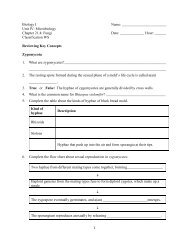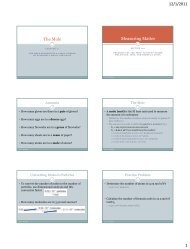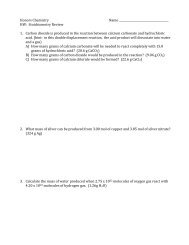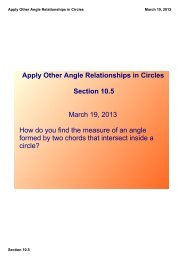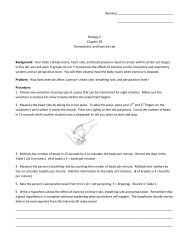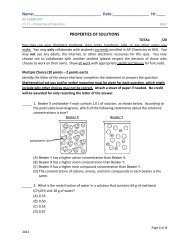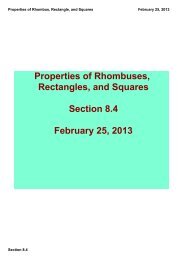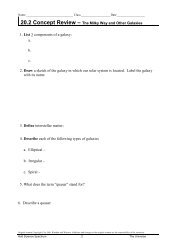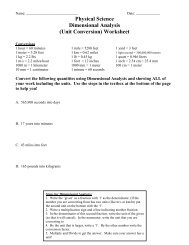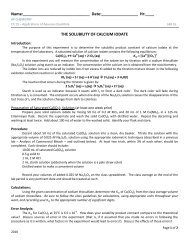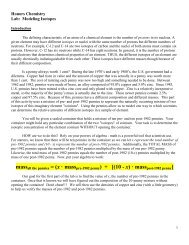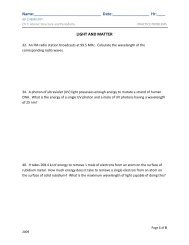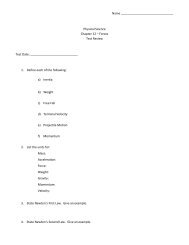Electrochemistry (Ch 17) - AP Chemistry
Electrochemistry (Ch 17) - AP Chemistry
Electrochemistry (Ch 17) - AP Chemistry
Create successful ePaper yourself
Turn your PDF publications into a flip-book with our unique Google optimized e-Paper software.
4/1/2011<br />
STANDARD REDUCTION POTENTIALS<br />
• The total potential (E cell ) can be measured (0.76 V), but there is no way to<br />
measure the individual electrode potentials.<br />
– To calculate potentials for each half-reaction, the reaction<br />
2 H + 2 e - H 2<br />
• where [H + ] = 1 M and P H2 = 1 atm<br />
– has been assigned a potential of 0V<br />
– E anode can be calculated because<br />
E° cell = E° anode + E° cathode<br />
• As a result, the reaction, ZnZn 2+ + 2 e - has a potential of 0.76 V<br />
• Using the standard hydrogen potential as a reference, all other potentials<br />
can be determined experimentally.<br />
<strong>Ch</strong> <strong>17</strong> - <strong>Electrochemistry</strong> 13<br />
STANDARD REDUCTION POTENTIALS<br />
• What is the potential of the cathode<br />
– Anode: Zn Zn 2+ + 2 e -<br />
– Cathode: Cu 2+ + 2 e - Cu<br />
• Since E° cell = E° anode + E° cathode<br />
– E° cat = 1.10 V – 0.76 V = 0.34 V<br />
• By convention, the potentials of<br />
half reactions are given as reduction<br />
potentials and are tabulated in<br />
standard states in a list of standard reduction potentials<br />
<strong>Ch</strong> <strong>17</strong> - <strong>Electrochemistry</strong> 14<br />
STANDARD REDUCTION POTENTIALS<br />
STANDARD REDUCTION POTENTIALS<br />
• Combining two half-reactions to obtain a balanced oxidationreduction<br />
reaction often requires two manipulations:<br />
– One of the reduction half-reactions must be reversed (since redox reactions<br />
must involve a substance being oxidized and a substance being reduced).<br />
• The half-reaction with the largest positive potential will run as written (as a<br />
reduction)<br />
• The other half-reaction will be forced to run in reverse (as an oxidation)<br />
• The net potential of the cell will be the difference between the two:<br />
E° cell = E° cathode – E° anode<br />
– Or “change the sign and add” (by changing the sign of the oxidation reaction)<br />
<strong>Ch</strong> <strong>17</strong> - <strong>Electrochemistry</strong> 15<br />
STANDARD REDUCTION POTENTIALS<br />
• Combining two half-reactions to obtain a balanced oxidationreduction<br />
reaction often requires two manipulations:<br />
– Since the number of electrons lost must equal the number gained, the halfreactions<br />
must be multiplied by integers as necessary to achieve the<br />
balanced equation. However, the value of E° is not changed when a halfreaction<br />
is multiplied by an integer.<br />
• Since a standard reduction potential is an intensive property, the potential is not<br />
multiplied by the integer.<br />
STANDARD REDUCTION POTENTIALS<br />
• Consider a galvanic cell based on the redox reaction<br />
Fe 3+ (aq) + Cu(s) Cu 2+ (aq) + Fe 2+ (aq)<br />
– The half reactions are:<br />
Fe 3+ + e - Fe 2+ E° = 0.77 V (1)<br />
Cu 2+ + 2 e - Cu E° = 0.34 V (2)<br />
– To balance the cell reaction and calculate the standard cell potential, reaction (2)<br />
must be reversed and multiply reaction (1) by two:<br />
Cu Cu 2+ + 2 e -<br />
– The cell reaction becomes:<br />
-E° = -0.34 V<br />
2 Fe 3+ + 2 e - 2 Fe 2+ E° = 0.77 V<br />
Cu(s) + 2 Fe 3+ (aq) Cu 2+ (aq) + 2 Fe 2+ (aq)<br />
E° cell = 0.43 V<br />
<strong>Ch</strong> <strong>17</strong> - <strong>Electrochemistry</strong> 18<br />
3




